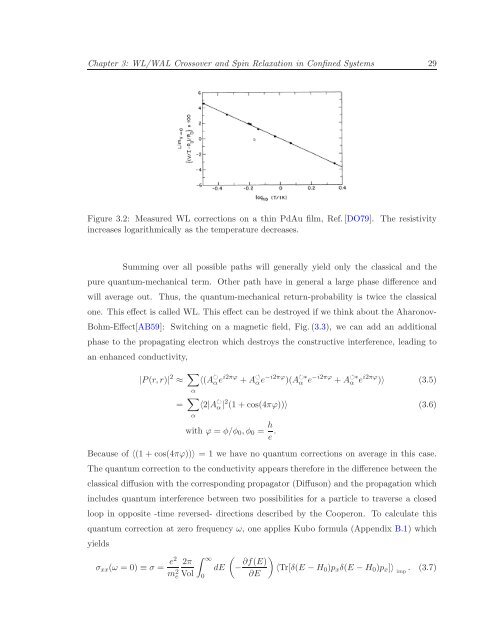Itinerant Spin Dynamics in Structures of ... - Jacobs University
Itinerant Spin Dynamics in Structures of ... - Jacobs University
Itinerant Spin Dynamics in Structures of ... - Jacobs University
You also want an ePaper? Increase the reach of your titles
YUMPU automatically turns print PDFs into web optimized ePapers that Google loves.
Chapter 3: WL/WAL Crossover and <strong>Sp<strong>in</strong></strong> Relaxation <strong>in</strong> Conf<strong>in</strong>ed Systems 29<br />
Figure 3.2: Measured WL corrections on a th<strong>in</strong> PdAu film, Ref.[DO79]. The resistivity<br />
<strong>in</strong>creases logarithmically as the temperature decreases.<br />
Summ<strong>in</strong>g over all possible paths will generally yield only the classical and the<br />
pure quantum-mechanical term. Other path have <strong>in</strong> general a large phase difference and<br />
will average out. Thus, the quantum-mechanical return-probability is twice the classical<br />
one. This effect is called WL. This effect can be destroyed if we th<strong>in</strong>k about the Aharonov-<br />
Bohm-Effect[AB59]: Switch<strong>in</strong>g on a magnetic field, Fig.(3.3), we can add an additional<br />
phase to the propagat<strong>in</strong>g electron which destroys the constructive <strong>in</strong>terference, lead<strong>in</strong>g to<br />
an enhanced conductivity,<br />
|P(r,r)| 2 ≈ ∑ α<br />
= ∑ α<br />
〈(A αe i2πϕ +A αe −i2πϕ )(A ∗<br />
α e −i2πϕ +A ∗<br />
α e i2πϕ )〉 (3.5)<br />
〈2|A α| 2 (1+cos(4πϕ))〉 (3.6)<br />
with ϕ = φ/φ 0 ,φ 0 = h e .<br />
Because <strong>of</strong> 〈(1 +cos(4πϕ))〉 = 1 we have no quantum corrections on average <strong>in</strong> this case.<br />
The quantum correction to the conductivity appears therefore <strong>in</strong> the difference between the<br />
classical diffusion with the correspond<strong>in</strong>g propagator (Diffuson) and the propagation which<br />
<strong>in</strong>cludes quantum <strong>in</strong>terference between two possibilities for a particle to traverse a closed<br />
loop <strong>in</strong> opposite -time reversed- directions described by the Cooperon. To calculate this<br />
quantum correction at zero frequency ω, one applies Kubo formula (Appendix B.1) which<br />
yields<br />
σ xx (ω = 0) ≡ σ = e2 2π<br />
m 2 e Vol<br />
∫ ∞<br />
0<br />
dE<br />
(<br />
− ∂f(E) )<br />
〈Tr[δ(E −H 0 )p x δ(E −H 0 )p x ]〉<br />
∂E<br />
imp<br />
. (3.7)
















